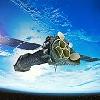 |
||
| First page | ||
 |
||
| Chandra | ||
 |
||
| Hubble Space Telescope | ||
 |
||
| Infrared Space Observatory | ||
 |
||
| Integral | ||
 |
||
| International Ultraviolet Explorer | ||
 |
Next Generation Space Telescope | |
 |
||
| XMM-Newton | ||
 |
||
| X-ray Timing Explorer | ||
 |
||
| Want to know more? | ||
 |
||
 |
||
The X-ray Multi-Mirror Mission
(1999-present)
The X-ray Multi-Mirror Mission, XMM-Newton, was launched December 10 1999 and is the most powerful X-ray telescope ever placed in orbit. Since Sir Isaac Newton was the man who "invented" spectroscopy and XMM is a spectroscopy mission the European Space Agency (ESA) has decided to include his name in the XMM mission.
The mission
Hopefully the mission will help solve many cosmic mysteries, ranging from black holes to the formation of galaxies. Violent processes in the sky generate X-rays, but since Earth's atmosphere blocks out these X-rays we have to place X-ray detectors in space. XMM will have a long list of targets to investigate thanks to the fact that many different types of objects generate X-rays; stars, binary systems, supernovae and things beyond our own galaxy; the Milky Way.
The satellite is travelling out to nearly one third of the distance to the Moon in a highly oval orbit which enables the astronomers to make very long and uninterrupted observations. Peering into deep space, XMM-Newton will considerably increase our knowledge of very hot objects created when the Universe was very young.
About the satellite
XMM-Newton is 10 metres long and weights almost 4 tonnes - it's almost as big as a bus. Because of it's weight it was launched on an Ariane-5, Europe's most powerful rocket!
XMM-Newton carries three very advanced X-ray telescopes, an optical/UV telescope and two star trackers. Each of the X-ray telescopes contain 58 high-precision mirrors. These Mirror Modules allow XMM-Newton to detect millions of sources, far greater than any previous X-ray mission, since it will be able to capture 60 per cent of incoming X-rays. It also has five X-ray imaging cameras and spectrographs.
Links
XMM-Newton Science Operations Centre, European Space Agency (ESA)
XMM-Newton, NASA
XMM UK Information centre
Latest news from ESA
14th August 2000
Sarah Amandusson
www_astro@mssl.ucl.ac.uk